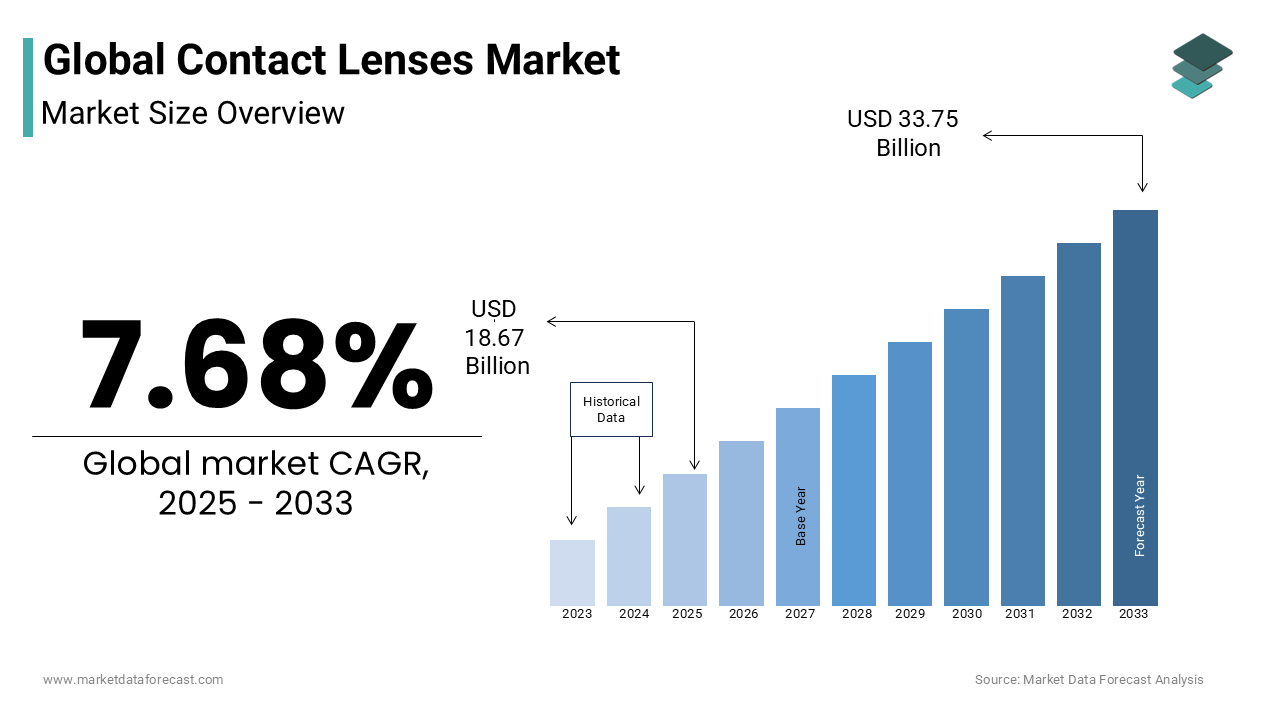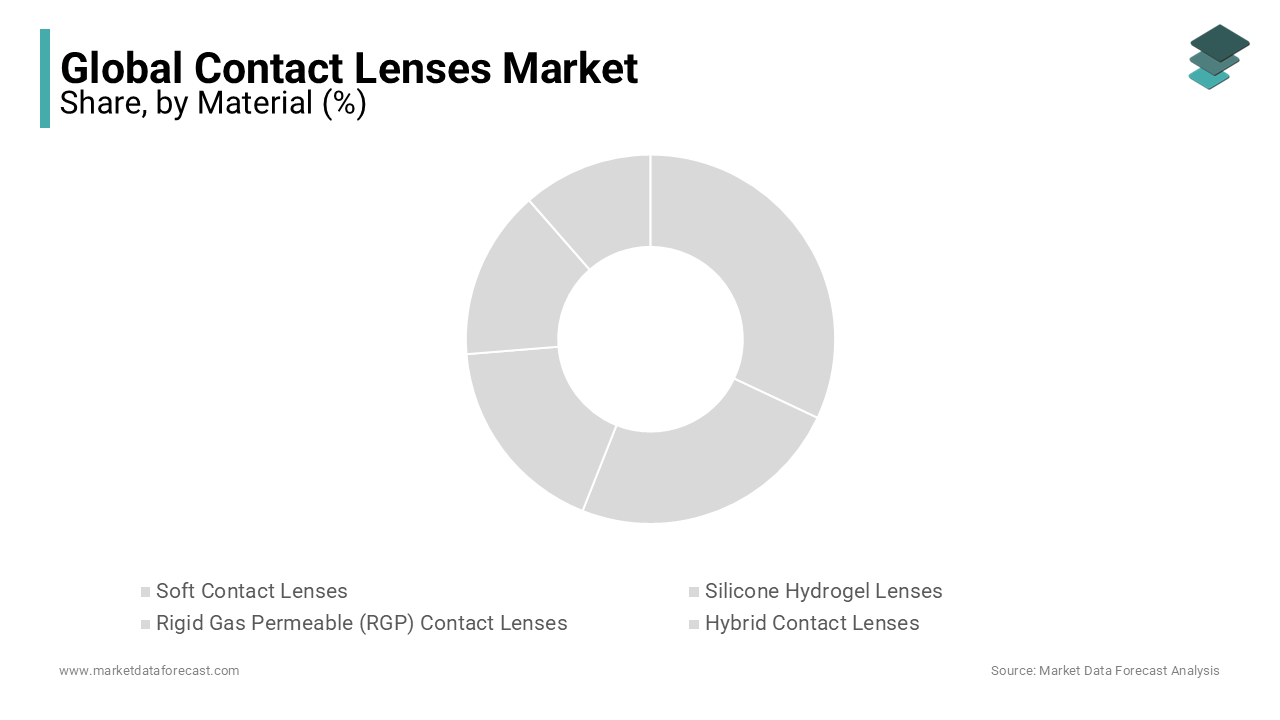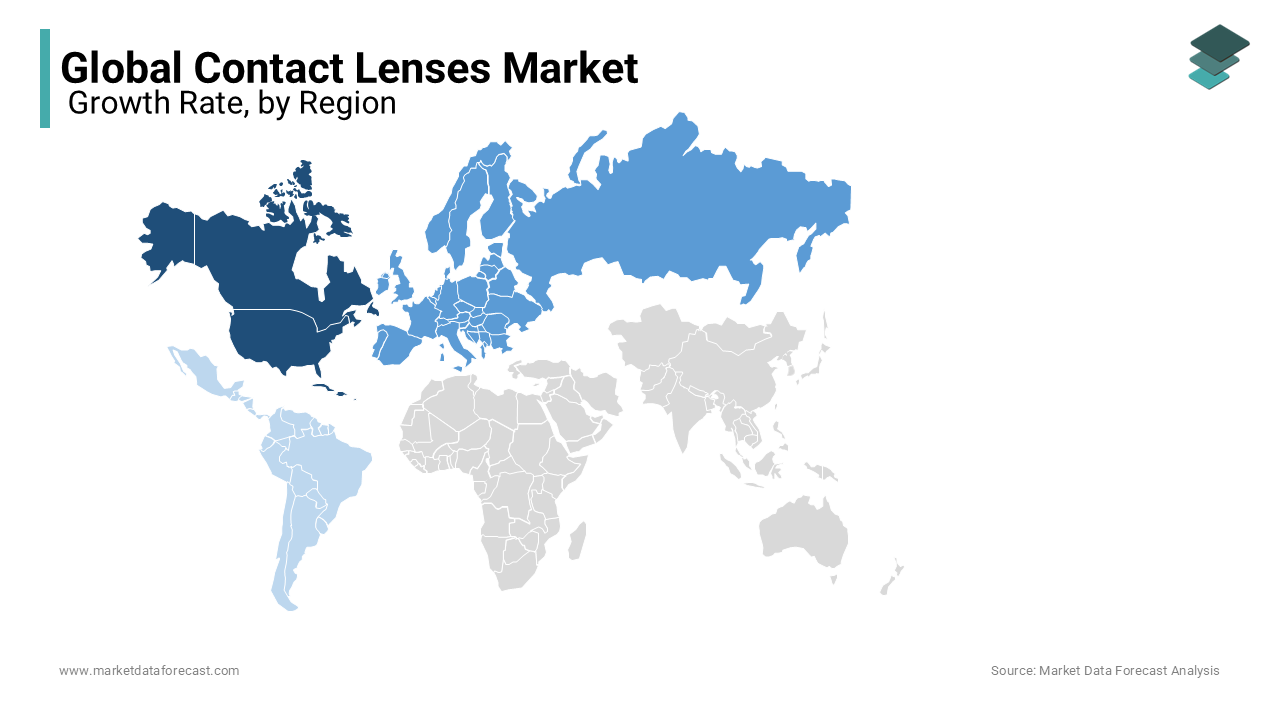Global Contact Lenses Market Size, Share, Trends and Growth Forecast Report - Segmented By Material (Soft, Silicone Hydrogel, Rigid Gas Permeable (RGP), Hybrid and Polymethyl Methacrylate (PMMA)), Application (Therapeutic, Cosmetic, Corrective and Prosthetic), Design, Modality, Distribution Channel and Region (North America, Europe, Asia-Pacific, Latin America, Middle East and Africa) – Industry Analysis From 2025 to 2033
Global Contact Lenses Market Size
The global contact lenses market was valued at USD 17.34 billion in 2024. The global contact lenses market is expected to reach USD 33.75 billion by 2033 from USD 18.67 billion in 2025, growing at a compound annual growth rate (CAGR) of 7.68% during the forecast period.

Current Scenario of the Global Contact Lenses Market
Contact lenses are a popular alternative to eyeglasses, which offer a more natural appearance and greater convenience. Contact lenses offer various benefits, and the primary advantage is that they provide a more natural appearance with an unobstructed view. The contact lenses market has witnessed notable market share in the past years and is projected to have prominent growth during the forecast period. The rising prevalence of eye problems, especially vision-related eye problems, is majorly contributing to the global contact lenses market revenue. According to a survey conducted by the COS in 2022, 41% of citizens have been diagnosed or have experienced at least one issue in eye health during the last two years. According to a WHO data update in October 2022, about 2.2 billion people worldwide suffer from near or distant vision impairment. The people's increasingly sedentary and modern lifestyles and increased demand for colored lenses in the cosmetic industry for aesthetic purposes propel market growth opportunities in the coming years.
MARKET DRIVERS
The growing patient volume suffering from vision problems is propelling the contact lenses market growth.
Across the world, the number of people suffering from visual impairments is growing considerably. The incidence of various eye diseases such as myopia, hyperopia, and presbyopia are also increasing with the growing age among people, promoting contact lens usage. Myopia has become a prevalent eye disorder worldwide, and the population affected is increasing each year. According to retinatoday.com, in 2010, 27% of the world's population, i.e., around 1.9 billion, had myopia, and this value is predicted to grow to 52% by 2050. According to the reports published by the World Health Organization (WHO), an estimated 2.2 billion people worldwide have near or distant vision impairment. The incidence of vision loss is higher among aged people. For instance, according to data from the Centers for Disease Prevention and Control (CDC), around 12 million people aged above 40 in the United States have vision impairment.
The growing aging population is another notable factor contributing to the contact lenses market growth.
According to the World Health Organization (WHO), the population of people 60+ years of age is expected to exceed 1.4 billion by 2030. With increasing age, people's vision ability decreases gradually, and they may also be diagnosed with diseases such as presbyopia and cataracts. In such situations, contact lenses can help significantly and also is a safe and effective way to correct their vision. The growing need to eliminate wearing spectacles all the time among the elderly is boosting the usage of contact lenses. Currently, people are living longer than ever before and the need for contact lenses among the elderly is expected to grow promisingly in the coming days and drive market growth.
Technological advancements are favoring the growth of the contact lenses market.
In recent days, technological developments have brought several changes in the design, materials and features and made contact lenses more comfortable, convenient, and effective. One such technological development in contact lenses is using improved materials in the manufacturing of contact lenses that can offer better oxygen permeability, which reduces the risk of eye infections and improves overall eye health. In recent years, the trend of customized contact lenses can be seen. Customized contact lenses are made as per the share of the eye of an individual and prescription and these provide a better fit and improved visual acuity. Smart contact lenses are another noteworthy example of the recent technological advancements in the market and the adoption of smart contact lenses is growing continuously owing to the benefits of smart contact lenses, such as intraocular pressure, glucose levels, and hydration.
In addition, growing adoption of contact lenses, rising demand for daily disposable contact lenses, increasing importance of contact lenses over prescription eye lenses, increasing disposable income, rising prevalence of eye diseases and injuries, and high healthcare expenditure promote the growth rate of the contact lenses market. Furthermore, the growing number of R&D activities happening in the optometry industry and the need to eliminate the usage of spectacles add fuel to the market's growth rate.
MARKET RESTRAINTS
The continuous use of contact lenses shows various side effects such as corneal edema, infection, red eye, and others, hampers the market growth due to limitations in the adoption rate. Lenses are prone to shifting, dryness, and other complications, which restrict the adoption among people. There is a high risk of bacterial infections with contact lens users. The infections can be caused by prolonged wear, build-up, bacteria, neglectful care, and sleeping with contact lenses on; these disadvantages will hinder the market share growth. The high costs associated with contact lenses compared to eyeglasses, particularly in cases of customized fittings, and the need for high maintenance to avoid other eye problems are estimated to impede the global contact lens market growth. The presence of stringent regulations by the healthcare system for approval of the desired products and discomfort in inserting and removing contact lenses are challenges in expanding the market size. Contact lenses are not an excellent choice for people with pre-existing eye conditions like allergies or chronic infections, limiting the market growth rate. The availability of various alternative therapies for vision correction and other eye problems at more efficient costs than contact lenses will restrict the growth of the contact lens market.
REPORT COVERAGE
|
REPORT METRIC |
DETAILS |
|
Market Size Available |
2024 to 2033 |
|
Base Year |
2024 |
|
Forecast Period |
2025 to 2033 |
|
Segments Covered |
By Material, Application, Design, Modality, Distribution Channel, and Region |
|
Various Analyses Covered |
Global, Regional & Country Level Analysis, Segment-Level Analysis, Drivers, Restraints, Opportunities, Challenges; PESTLE Analysis; Porter's Forces Analysis, Competitive Landscape, Analyst Overview of Investment Opportunities |
|
Regions Covered |
North America, Europe, Asia Pacific, Latin America, Middle East & Africa |
|
Market Leader Profiled |
Johnson & Johnson, Bausch & Lomb, Cooper Vision, Hydrogel Vision Corp, Abbott Medical Optics, Inc., Alcon Laboratories, Inc., Carl Zeiss AG, CIBA Vision, Essilor International, and Contamac. |
SEGMENTAL ANALYSIS
By Material Insights

Based on material, the soft contact lenses segment is expected to hold the highest share of the global contact lenses market during the forecast period. The growing population suffering from vision problems, increasing preference for contact lenses over traditional spectacles and benefits of soft contact lenses such as comfort, convenience and breathability drive the segmental growth.
In contrast, the rigid gas permeable (RGP) contact lenses segment is estimated to showcase the highest CAGR during the forecast period. The growing demand for high-quality vision correction, particularly among people with complex vision problems that cannot be corrected with soft contact lenses primarily boosts the segment’s growth rate.
On the other hand, the hybrid contact lenses segment is anticipated to register a healthy CAGR in the coming years owing to the increased use of hybrid lenses by people with astigmatism and keratoconus. The growth of the segment is further driven by the growing need for customized vision correction options that can provide both comfort and sharp vision.
By Application Insights
Based on the application, the corrective contact lenses market held the largest share of the worldwide market in 2024 and is anticipated to lead the market during the forecast period, growing at a CAGR of 6%. These contact lenses are designed for medical purposes, which aid in relieving eye pain and healing the cornea. The rising prevalence of vision problems and the growing preference for contact lenses over eyeglasses majorly promote segmental growth.
The therapeutic contact lenses segment had a substantial share of the global market in 2024 and is expected to rise at a promising CAGR during the forecast period. The increasing patient population suffering from eye diseases such as dry eyes, corneal ulcers, and other forms of eye trauma primarily boosts the segment’s growth rate. The rising demand for non-invasive treatment options for vision correction is another key factor propelling segmental growth.
The cosmetic contact lenses segment is estimated to showcase a notable CAGR during the forecast period owing to the growing demand for aesthetic options and the rising popularity of special effects in movies and TV shows.
The prosthetic contact lenses segment is predicted to witness a healthy CAGR during the forecast period. The segmental growth is majorly driven by the rising demand for specialized vision correction options and the growing acceptance of contact lenses as a viable treatment option for eye disorders.
By Design Insights
Based on the design, the spherical lens segment is predicted to occupy the most significant share of the global market during the forecast period. The segmental growth is majorly driven by the increasing prevalence of refractive errors worldwide, the availability of a wide range of spherical contact lenses and the rising adoption of contact lenses.
The toric segment was the second biggest segment in the worldwide contact lenses market in 2024 and is expected to showcase a healthy CAGR during the forecast period. Factors such as the growing patient population suffering from astigmatism, the increasing aging population, availability of a wide range of toric contact lenses and growing awareness about the benefits of using toric contact lenses over glasses, such as better visual acuity, improved comfort, and reduced dependence on glasses majorly accelerates the segment’s growth rate.
By Modality Insights
Based on modality, the disposable segment is forecasted to register the highest CAGR during the forecast period owing to the awareness regarding the benefits associated with disposable contact lenses. The growing demand for convenience and reduced risk of eye infections associated with disposable lenses and increasing adoption of technological advancements in the manufacturing processes are boosting the growth rate of the segment. Under the sub-segments, the daily disposable segment is predicted to showcase rapid growth during the forecast period due to the convenience and hygiene benefits they offer.
The conventional segment accounted for a substantial share of the global market in 2023 and is expected to grow at a moderate CAGR during the forecast period.
By Distribution Channel Insights
Based on the distribution channel, the eye hospitals and spectacle stores segment accounted for the major share of the contact lenses market in 2022 and is expected to grow at a healthy CAGR during the forecast period. Factors such as the growing prevalence of vision disorders, especially among the aging population, and the rising demand for corrective lenses and other vision aids majorly drive segmental growth.
However, the online segment is gaining attention and is expected to witness a boom soon and is predicted to display a CAGR of 7.45% during the forecast period. The growing consumer preference for e-commerce and the convenience of ordering contact lenses from the comfort of one's home is one of the key factors propelling segmental growth. In addition, the growing availability of contact lenses online, with major manufacturers and retailers expanding their online presence and rising adoption of e-commerce platforms and the growing trend of online eyewear shopping further promote the growth rate of the segment.
REGIONAL ANALYSIS

Geographically, the North American region dominated the market in 2024 and is expected to hold the largest share of the global contact lenses market during the forecast period. Common eye diseases related to age, increasing healthcare expenditure, and increasing disposable income are the key factors propelling the market demand in this region. The United States had the most significant share of the global market in 2024 and is anticipated to account for the largest share of the North American market in the coming years. On the other hand, the Canadian market is predicted to showcase a healthy CAGR during the forecast period in this region.
Europe held the second-largest global market share in 2024. During the forecast period, the European region is estimated to have a decent occupancy in the global market. The growing adoption of technological developments in manufacturing contact lenses is one of the major factors propelling the European market growth. U.K. and Germany had the major share of the European region in 2021 and are likely to continue dominating the European region during the forecast period. In addition, the aging population across the European region is growing consistently, which is expected to contribute to the regional market's growth.
The Asia-Pacific region is one of the potential regions worldwide and is expected to grow the fastest during the forecast period. The Chinese market is expected to showcase healthy growth in the coming years as the adoption of contact lenses from China is witnessing significant growth. On the other hand, the Japanese market is expected to witness considerable growth during the forecast period. To increase the appearance of the eyes, consumers in Japan are importantly adopting contact lenses, propelling the market growth in Japan. On the other hand, the Indian market is anticipated to project the fastest growth during the forecast period owing to the increasing awareness among people regarding contact lenses and improved willingness from people towards contact lenses.
Latin America is predicted to witness notable growth in the upcoming years. The contact lenses market in the Middle East and Africa is expected to gain momentum and register healthy growth during the forecast period. Increasing agreements to manage contact lenses, develop healthcare facilities, develop medical tourism, improve the healthcare industry, and raise knowledge about contact lenses are contributing to the growth of contact lenses in the countries of the Middle East and Africa.
KEY PLAYERS IN THE GLOBAL CONTACT LENSES MARKET
Johnson & Johnson, Bausch & Lomb, Cooper Vision, Hydrogel Vision Corp, Abbott Medical Optics, Inc., Alcon Laboratories, Inc., Carl Zeiss AG, CIBA Vision, Essilor International, and Contamac are some of the noteworthy companies operating in the global contact lenses market and profiled in this report.
Companies such as Johnson & Johnson, Novartis, The Cooper Companies, and Bausch & Lomb occupy most global contact lenses market shares. The key market participants focus on bettering their brand value and customer base to acquire the best possible market share and joining long-term associations with the suppliers and distributors to increase their sustainability and strengthen their regional presence.
RECENT MARKET HAPPENINGS
- In October 2023, Alcon launched the TOTAL30 multifocal lenses for patients with presbyopia. The lenses will be distributed in the U.S. and in some international markets.
- In March 2023, Cooper Companies Inc. launched its Cooper Vision My Day Energy lenses in the U.S. market. The lenses are for people with symptoms of pervasive digital eye strain.
- In June 2023, Bausch and Lomb combined launched multifocal silicone hydrogel lenses, Bausch and Lomb Infuse, in the U.S. market. This daily disposable lens provides a clear vision for patients with presbyopia.
- In February 2023, Alcon launched a new total toric lens for astigmatic patients. This launch expands the company's daily disposable and reusable lens portfolio with high-performing options designed especially for astigmatic patients.
- In April 2022, Alcon launched Precision, Canada's disposable contact lens for astigmatism. The daily disposable silicone hydrogel contact lenses are designed for myopic patients, continuing Alcon's mission to help people's vision.
- In June 2022, Johnson & Johnson Vision, a part of Johnson & Johnson MedTech, received FDA clearance for its latest contact lens innovation, Acuvue Oasys Maz 1-Day, and Acuvue Oasys Max 1-Day Multifocal.
- In 2022, Cooper Companies Inc. invested USD 110.30 million in research and development activities compared to USD 92.70 million in 2021. These activities mainly focus on manufacturing technology, lens development, and process enhancements.
MARKET SEGMENTATION
This research report on the global contact lenses market has been segmented & sub-segmented based on the material, application, design, modality, distribution channel, and region.
By Material
- Soft Contact Lenses
- Silicone Hydrogel Lenses
- Rigid Gas Permeable (RGP) Contact Lenses
- Hybrid Contact Lenses
- Polymethyl Methacrylate (PMMA) Contact Lenses
By Application
- Therapeutic
- Cosmetic
- Corrective
- Prosthetic
By Design
- Spherical
- Bifocal
- Orthokeratology
- Toric
By Modality
- Conventional
- Disposable
- Daily
- Monthly
- Other Disposable Modalities
By Distribution Channel
- Eye Hospitals and Spectacle stores
- Online
By Region
- North America
- Europe
- Asia Pacific
- Latin America
- The Middle East and Africa
Frequently Asked Questions
Which region accounted for the largest share in the global contact lenses market in 2024?
The North American region dominated the market in 2024 and is expected to hold the largest share of the global contact lenses market during the forecast period.
Which country led the global contact lenses market in 2024?
The U.S. accounted for the largest share of the global market in 2024 and occupied over 25%.
Which are the significant players operating in the contact lenses market?
Johnson & Johnson, Bausch & Lomb, Cooper Vision, Hydrogel Vision Corp, Abbott Medical Optics, Inc., Alcon Laboratories, Inc., Carl Zeiss AG, CIBA Vision, Essilor International, and Contamac are some of the notable companies in the contact lenses market.
Related Reports
Access the study in MULTIPLE FORMATS
Purchase options starting from $ 2500
Didn’t find what you’re looking for?
TALK TO OUR ANALYST TEAM
Need something within your budget?
NO WORRIES! WE GOT YOU COVERED!
Call us on: +1 888 702 9696 (U.S Toll Free)
Write to us: [email protected]
